Trieste is a city that enchants with its unique location between the sea and the Karst hills. Known for its cosmopolitan atmosphere, has been a crossroads of different cultures and influences that are reflected in its architecture, cuisine and daily life. During your trip to Trieste, you will discover a city that combines Central European charm with Mediterranean warmth, making it an unmissable destination for those who love to travel and discover new places.
Piazza Unità d'Italia is undoubtedly the ideal starting point for exploring Trieste. This square, one of the largest in Europe overlooking the seais surrounded by beautiful historical buildings that bear witness to the city's Austro-Hungarian past. Each building here has a unique history, contributing to an atmosphere full of charm and history.
Among the main points of interest in the square are the Town Hall Buildingan imposing and majestic building that houses the municipal offices. This building, with its neoclassical architecture, is one of the symbols of the city and a perfect example of the grandeur and historical importance of Trieste. Next to it, the Model Palace catches the eye with its elegant lines and decorative details reminiscent of the city's imperial past. No less important is the Pitteri Palacethe oldest in the square, built in 1790, which represents another significant piece of Trieste's architectural mosaic.
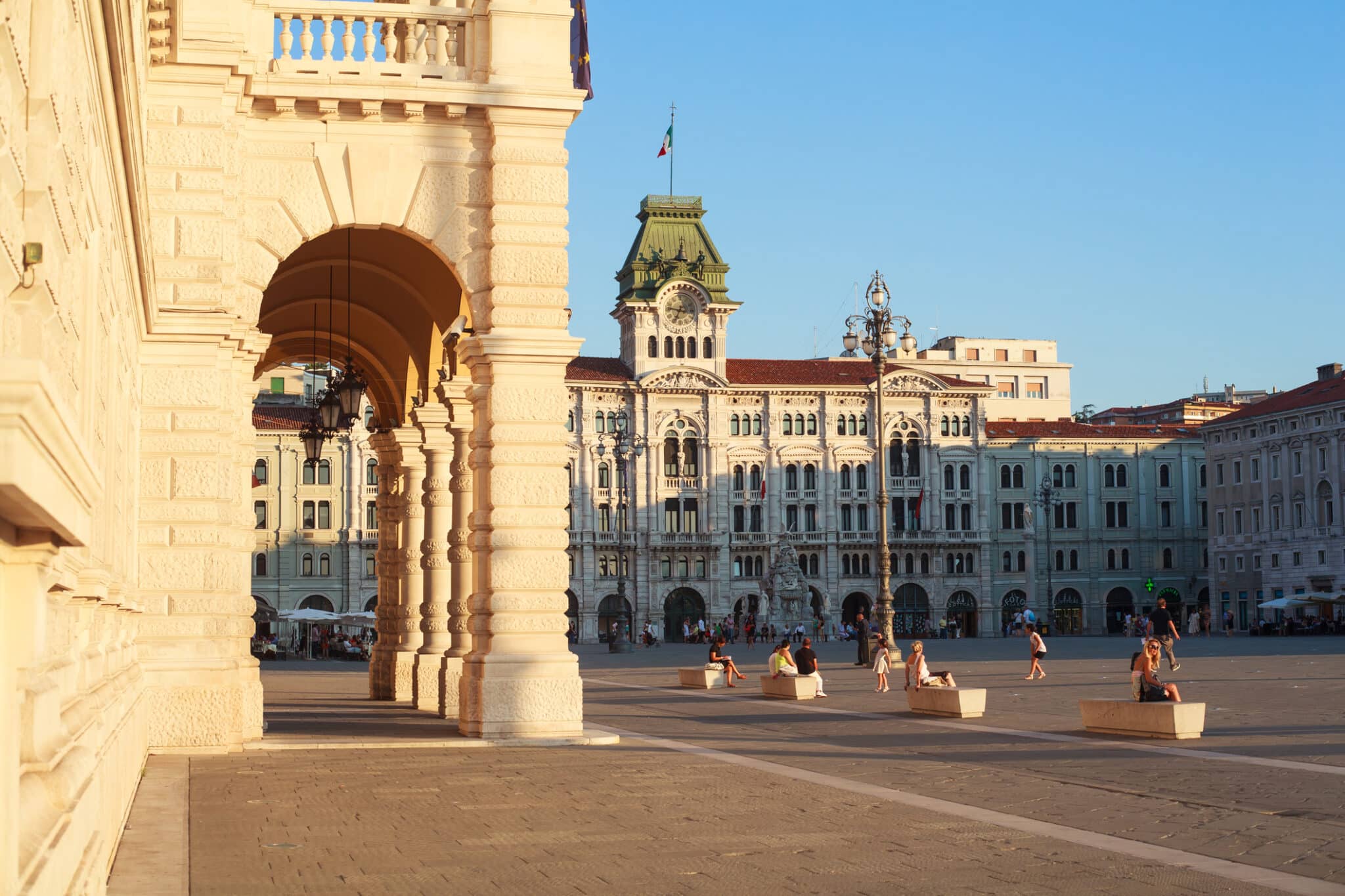
Piazza Unità d'Italia, Trieste. View of Piazza Unità d'Italia in Trieste
At night, the square is transformed into a light show. Buildings are illuminated, creating a magical atmosphere that invites you to stroll around and enjoy the fresh sea air. La gulf view is breathtaking and offers a panorama that is hard to forget. Walking along the Audace pier, which extends some 200 metres into the sea, one has a unique perspective on the square and the surrounding city.
Don't forget to make a stop at one of the historic cafes surrounding the square, such as the Cafe degli Specchi. This historic café, founded in 1839, is the perfect place to enjoy a good Italian coffee while admiring the view of the gulf. The Caffè degli Specchi has been frequented by famous people and continues to be a meeting point for tourists and residents alike. Here, while sipping a coffee, you can breathe in the vibrant atmosphere of the city and feel part of its history.
The Lloyd Palacenow the headquarters of the Friuli Region Venice Juliais one of the most representative buildings of Austro-Hungarian architecture in Trieste. Built between 1880 and 1883the building originally housed the headquarters of the shipping company Austrian Lloydone of the most important of the period. This building is a symbol of the grandeur and prosperity that Trieste achieved during the Austro-Hungarian era, when the city was one of the main ports of the Empire.
The building, with its elegant façade and refined interior, perfectly represents the architectural style of the time. The façade is adorned with rich and sophisticated decorative details, reflecting imperial grandeur. The palace's equally magnificent interior was designed to house the shipping company's offices and reception rooms. These spaces were intended to impress visitors and reflect the power and influence of Austrian Lloyd.
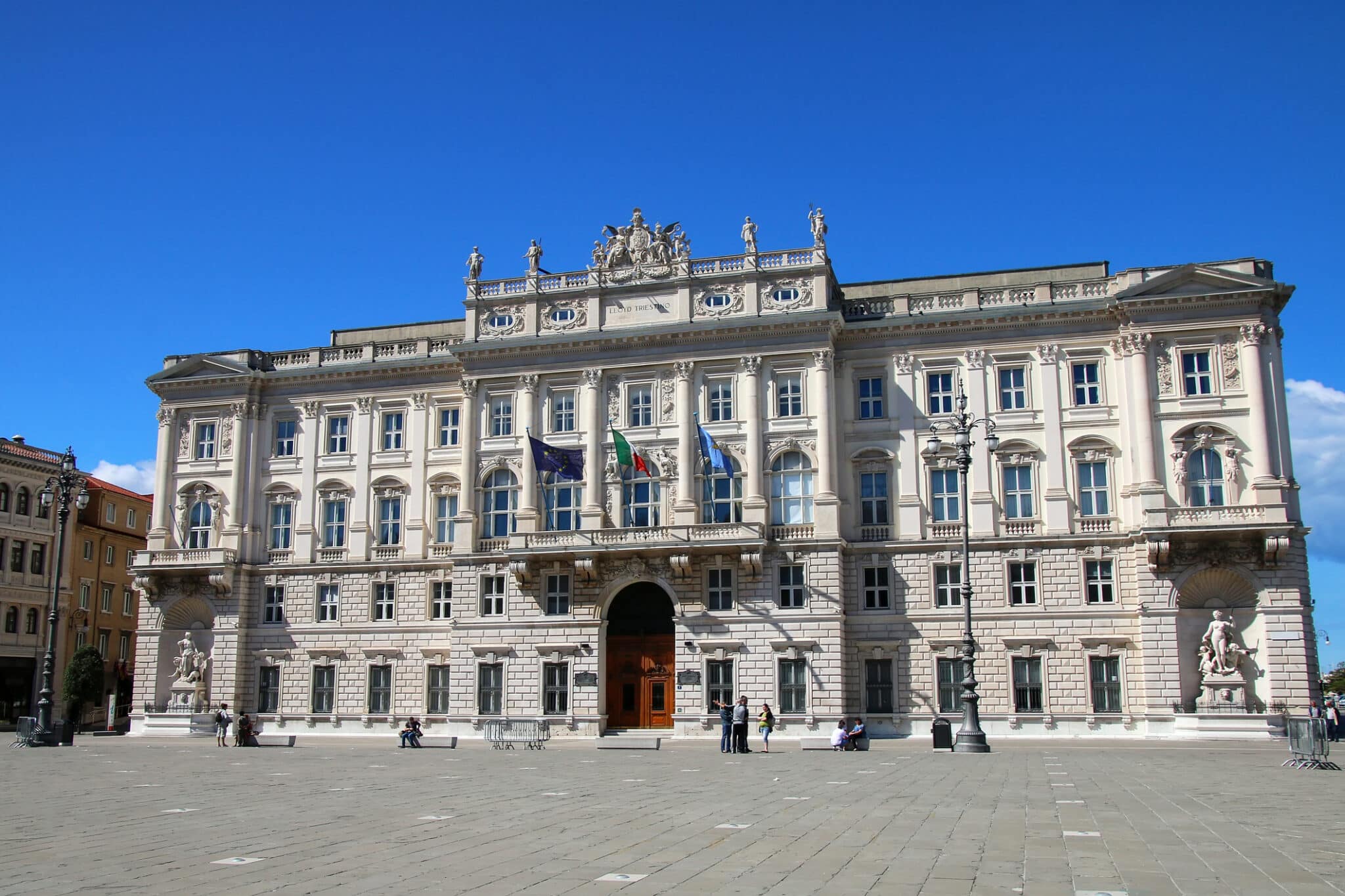
Lloyd Triestino building in Piazza Unità d'Italia in Trieste, Italy
During the 19th century, Trieste was a crossroads of trade and cultures, and the Lloyd Palace was one of its main symbols. The shipping company Lloyd Austriaco played a crucial role in the city's maritime economy, with a fleet connecting Trieste to the main ports of the Mediterranean and beyond. The palace was not only an operational centre, but also a place where important business and diplomatic meetings took place, helping to consolidate Trieste's role as a bridge between central Europe and the Mediterranean world.
Today, the Lloyd Palace continues to be a symbol of the maritime history of the city and an important administrative centre. Its conversion into the seat of the Friuli Venezia Giulia Region testifies to its historical and architectural importance. Visiting the palace offers the opportunity to take a plunge into the past and appreciate the elegance and refinement of an era that left an indelible mark on Trieste.
La Statue of James Joyce in Trieste celebrates the special bond between the great Irish writer and the city. Joyce lived in Trieste for over a decade, during which he wrote significant parts of his most famous works, such as Dubliners e Ulysses. The statue, located on the Ponterosso bridgedepicts Joyce in a dynamic pose, almost as if she were walking along the canal, reflecting her restless and creative spirit.
This tribute is a cultural landmark that attracts many literature enthusiasts and tourists curious to learn more about the life of one of the 20th century's most influential authors. The statue was inaugurated in 2004, on the occasion of the centenary of Joyce's arrival in Trieste. The work, created by sculptor Nino Spagnoli, captures the essence of Joyce, representing him with his hat and cane, distinctive elements of his style.
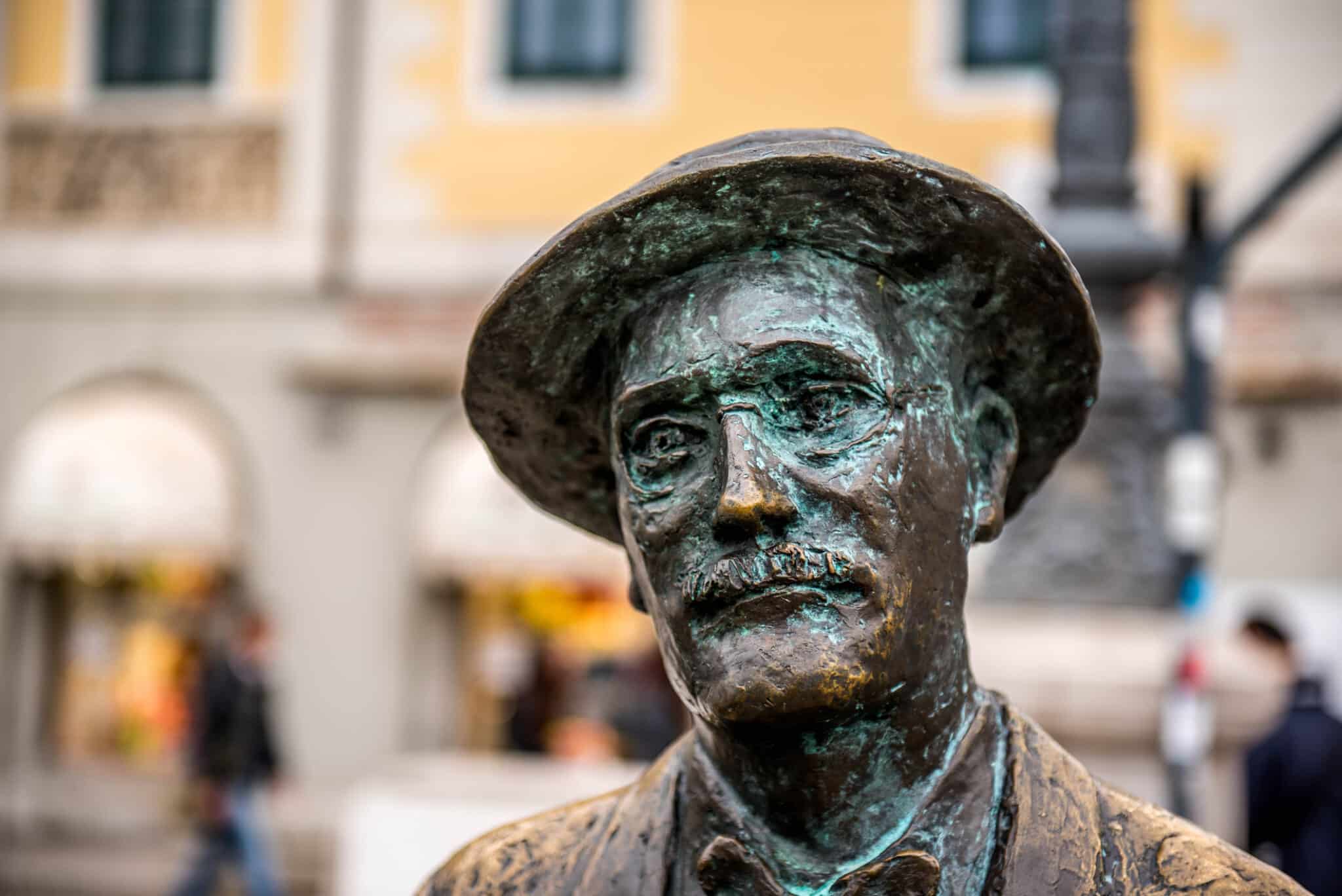
The statue of James Joyce in Trieste. The bronze statue of the famous Irish novelist James Joyce stands overlooking the Canale Grande in Trieste, Italy
During his stay in Trieste, Joyce not only wrote, but also taught English and was part of the city's vibrant cultural scene. His presence in Trieste was instrumental in the development of his literary career, and the city, with its cosmopolitan and multicultural environment, profoundly influenced his work. The statue is a tribute to this prolific period in Joyce's life and a testimony to the deep connection between the writer and Trieste.
Visit the statue of James Joyce is an unmissable experience for those who love literature and want to discover the places that inspired one of the greatest authors of the 20th century. Walking along the canal, one can easily imagine Joyce immersed in his thoughts, perhaps reflecting on his stories and characters. The statue is not only a monument, but also an invitation to explore Trieste through Joyce's eyes and to discover the connections between the city and his works.
La Statue of Le Sartine is a tribute to the working women of Trieste, in particular the seamstresses that have played a fundamental role in the city's economic history. Located in Piazza Venezia, the statue represents two women intent on sewing, a symbol of the work and dedication of Triestine seamstresses. This monument was inaugurated in 2009 and created by the Triestine sculptor Nino Spagnoli.
Trieste's seamstresses have had a significant impact on the city's industrial and craft history, contributing to the local economy through their work. During the 19th and 20th centuries, the textile and tailoring sector was one of the main areas of work for Triestine women, who worked hard to support their families and improve their living conditions. The statue celebrates their commitment and craftsmanship, recognising the value of their contribution to society.
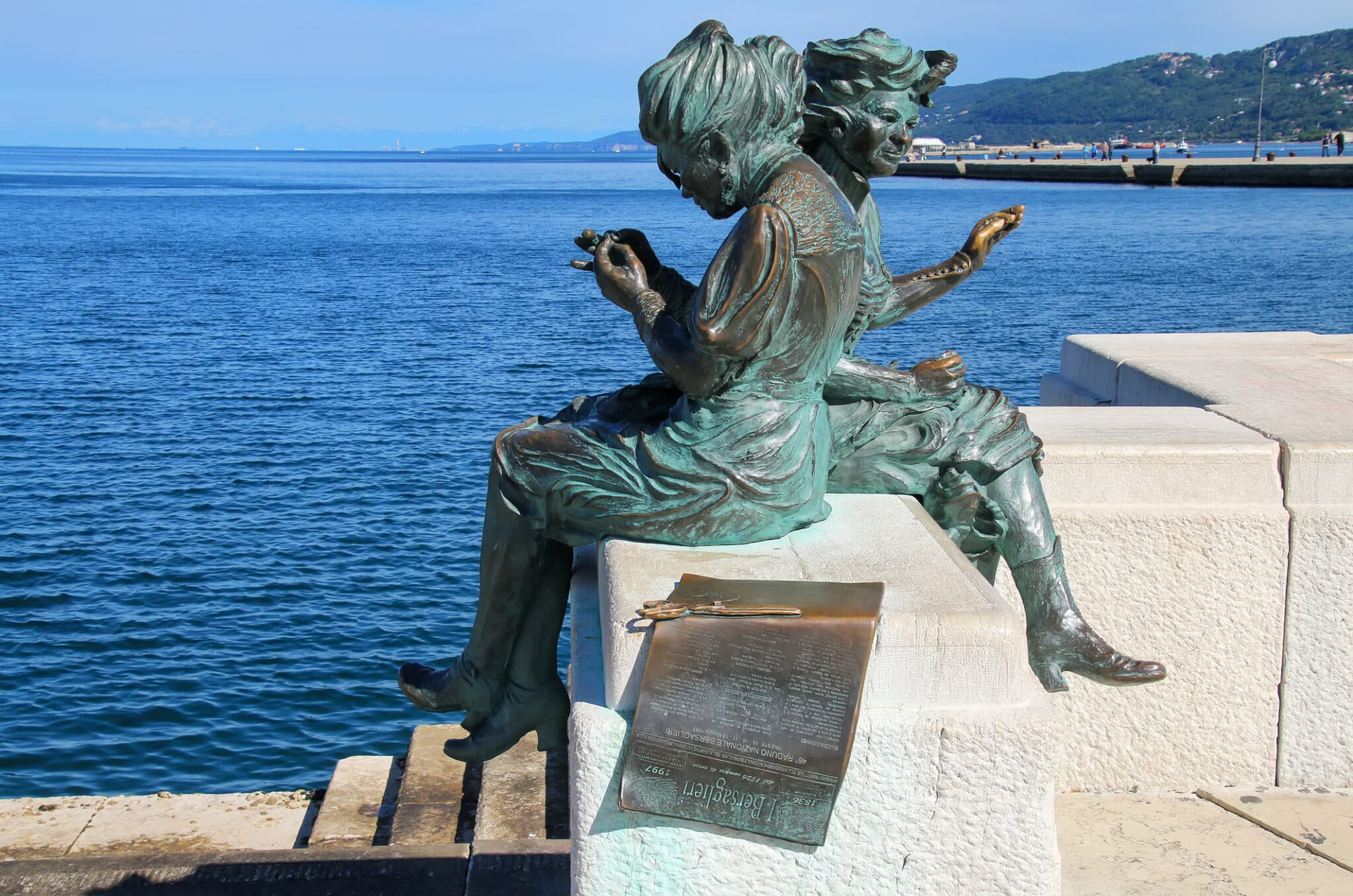
Statue of Le Sartine on the Trieste waterfront in Italy. Trieste is the capital of the autonomous region Friuli-Venezia Giulia
La Statue of Le Sartine not only celebrates the contribution of women to Trieste society, but also invites us to reflect on the value of work and the dignity of craft professions. The sculpture captures a moment of everyday life and transforms it into a work of art, paying tribute to all the women who, with their silent and often unrecognised work, have contributed to the growth and development of the city. The concentrated expressions of the two women and the precision of their movements suggest a dedication and passion that transcends the simple act of sewing.
This monument is a point of interest that offers food for thought on the city's past and present. It represents a tangible link between past generations of women workers and the present, emphasising the importance of recognising and valuing manual and artisanal work. The statue has become a place of gathering and commemoration, where visitors can pay tribute to the seamstresses and reflect on the social and economic history of Trieste.
A few kilometres from the centre of Trieste, overlooking the sea, lies the Miramare Castlea place that seems straight out of a fairy tale. This splendid castle was built in the 19th century at the behest of Archduke Ferdinand Maximilian of Austria and his wife Charlotte of Belgium. Their dream was to create a residence that reflected the beauty of the surrounding landscape and the elegance of their era.
Surrounded by a vast botanical park of about 22 hectares, the Miramare Castle offers breathtaking views of the Gulf of Trieste. The park is a masterpiece of gardening, with a variety of exotic and native plants that create an enchanting and serene environment. Strolling through the park's paths, you can admire statues, fountains and pavilions that add a touch of romance to the landscape.
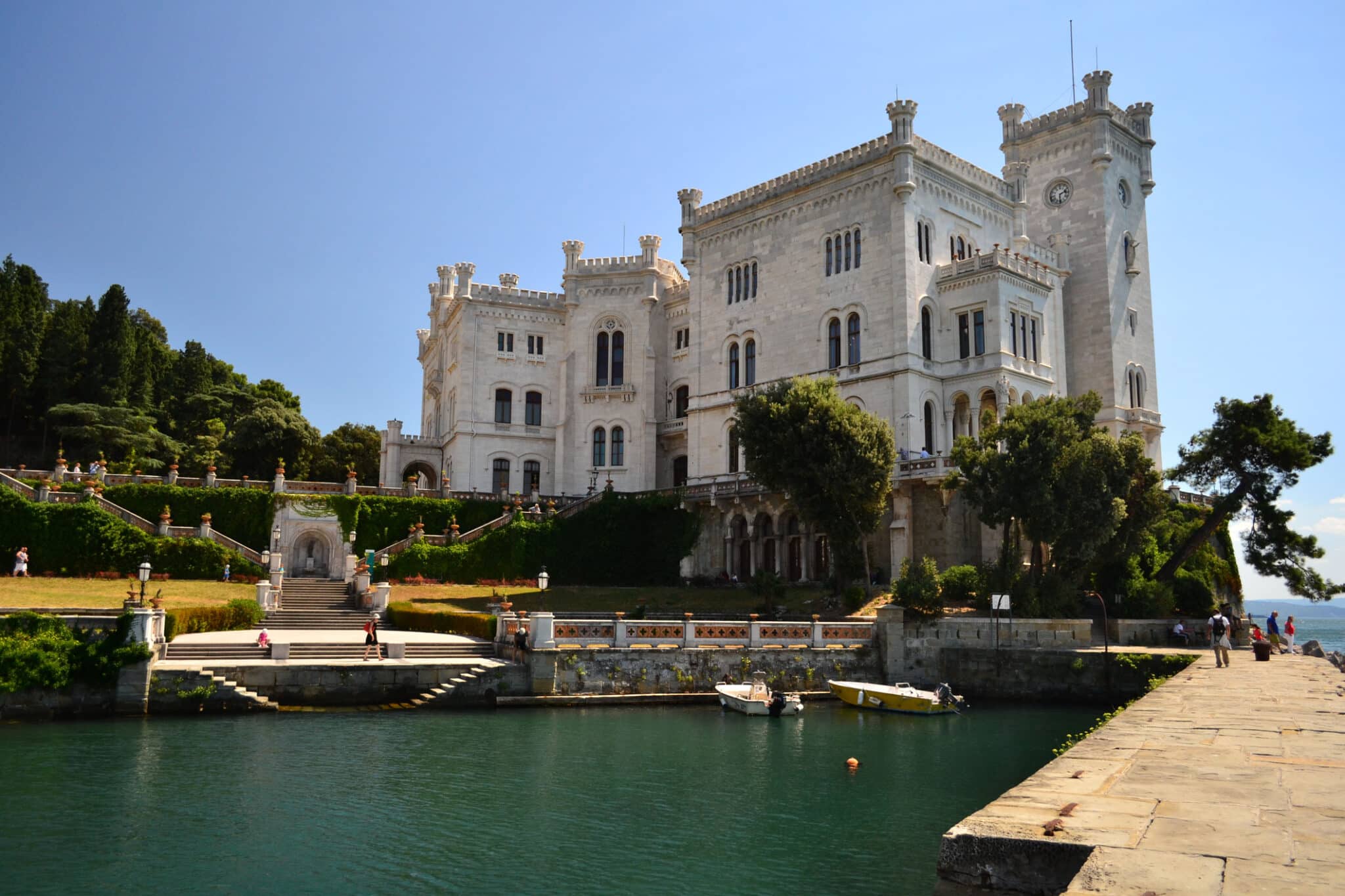
View of Miramar Castle, Trieste, Italy
The rooms inside the castle are richly decorated and tell the fascinating story of Maximilian and Charlotte. Each room is a journey through time, with original furnishings, works of art and details reflecting the lifestyle of the nobility of the time. La Throne Room, the Music Hall and the Carlotta's Bedroom are just some of the rooms that are worth a visit for their beauty and the atmosphere they evoke.
A visit to the castle is a journey through time that will make you relive the romantic atmosphere of the imperial era. The Miramare Castle is not only a historical monument, but also a place of great charm and natural beauty. Its privileged location, overlooking the sea, and its fascinating architecture make it one of the attractions most visited and loved in Trieste.
For history lovers, the Roman Theatre of Trieste is a must-see. Located in the heart of the city, this ancient theatre dates back to the 1st-2nd century AD and could seat up to 6000 spectators. The theatre is surprisingly well preserved and offers a fascinating insight into the cultural life of ancient Tergeste, the Roman name for Trieste.
The Roman Theatre was built during the time of Emperor Trajan, and its strategic location at the foot of the San Giusto hill made it a central venue for theatrical performances and shows. The theatre's structure, with its semi-circular cavea and raised stage, is a classic example of Roman theatre architecture.
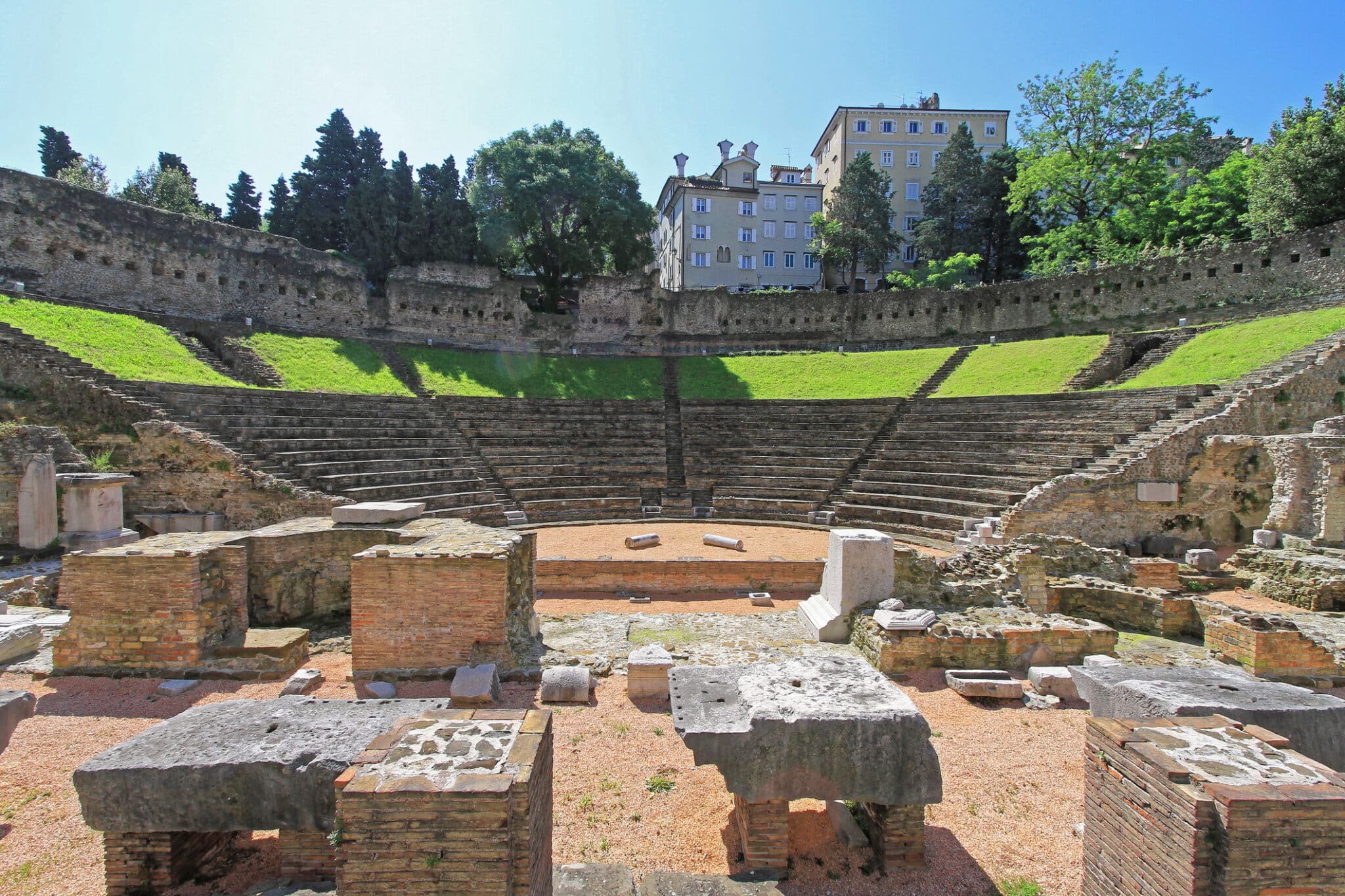
Roman Theatre of Trieste
As you stroll through the ruins, imagine the performances that were held here centuries ago: Greek tragedies, Roman comedies and mime shows. Each stone of the theatre tells a story and transports you back in time, offering an experience that will make you feel part of the city's thousand-year history. The well-preserved tiers of seats allow you to visualise how audiences of the time could enjoy performances, creating a tangible link with the past.
The Roman Theatre is today a place of great archaeological and cultural importance, and often hosts events and performances that keep the city's theatre tradition alive. By visiting the theatre, you will have the opportunity to explore one of the hidden treasures of Trieste and to better understand the importance of the city during the Roman Empire.
For those seeking a different experience, the Giant Cave is one of Trieste's most surprising attractions. Located just a few kilometres from the centre, this karstic cave is famous for its colossal dimensions: it is the largest natural cave in the world accessible to tourists. The cave, discovered in 1840, has attracted the attention of speleologists and visitors from all over the world.
The guided tour of the Giant Cave will take you to a depth of 100 metres, where you can admire the spectacular formations of stalactites e stalagmites. These formations, created over thousands of years, offer a natural spectacle of incredible beauty. The main hall of the cave is over 100 metres long, 65 metres wide and about 107 metres high, dimensions that make this cave unique in the world.
During the visit, expert guides will explain the geology of the cave and its formation. You will be able to see the speleologists' calendar, a series of measurements that are carried out to study the movements of the earth's crust. This will allow you to better understand the natural phenomena that have shaped the cave over the centuries.
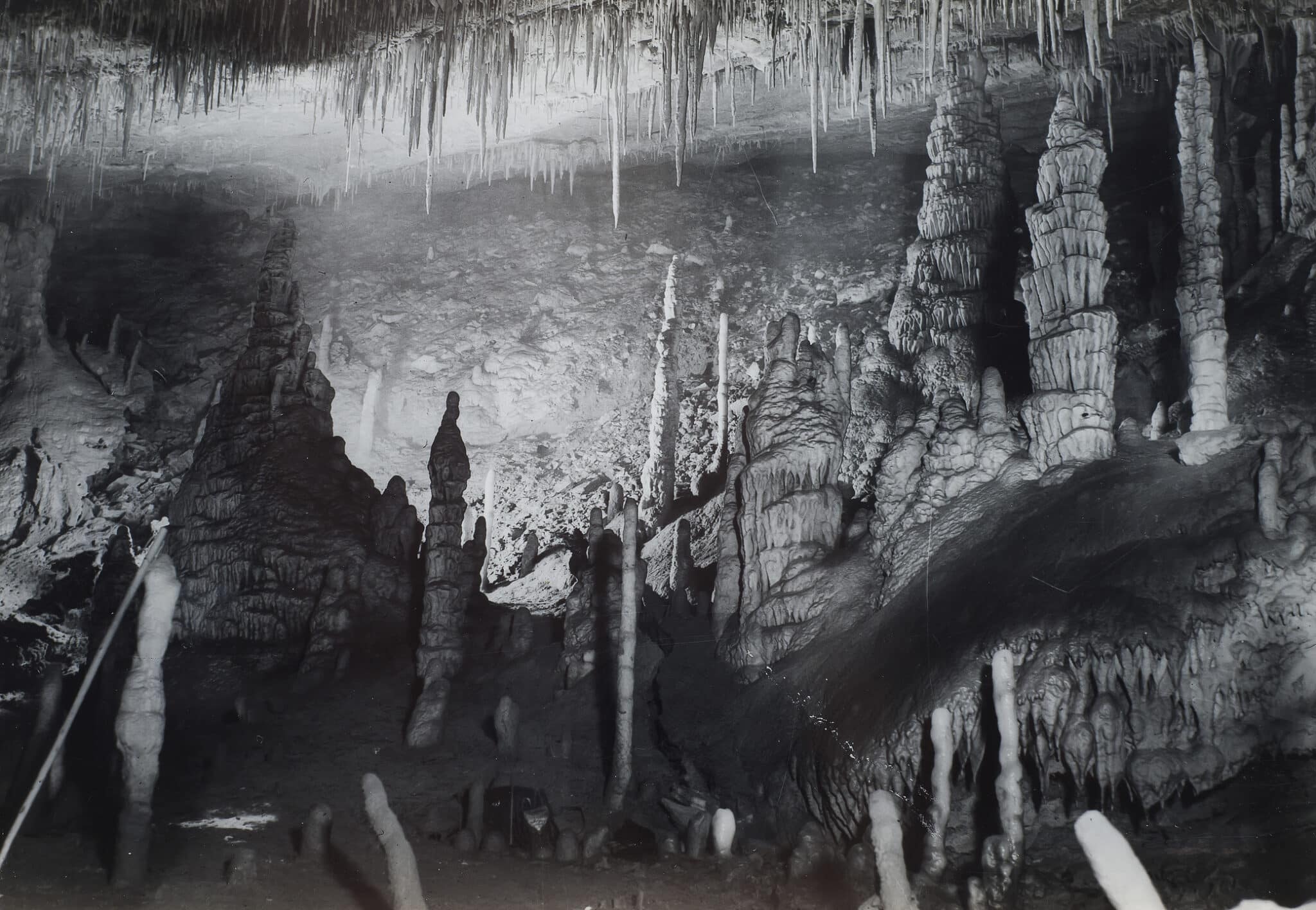
Giant Cave of Trieste
La Giant Cave is a marvel of nature that will leave you speechless and is an unforgettable adventure for young and old alike. The temperature inside the cave is constant all year round, around 11 degrees Celsius, so it is advisable to bring a jacket even in summer. The visit to the cave takes about an hour and involves descending and ascending more than 500 steps, but the experience is definitely worth the effort.
This cave is a perfect example of the hidden wonders of the Trieste Karstan area rich in karst phenomena and natural beauty. Exploring the Grotta Gigante will give you a unique perspective on the geology of the region and allow you to discover one of Trieste's best-kept secrets.
For an immersion in the culture and in art, the Revoltella Museum is an unmissable stop. Founded by Baron Pasquale Revoltella in the 19th century, the museum houses a rich collection of art modern, with works by Italian and international artists. Baron Revoltella was a passionate art collector and wanted to create an institution that could promote contemporary art and enrich the cultural life of the city.
The museum rooms, spread over several floors, offer a comprehensive overview of contemporary art from the 19th century to the present day. Among the most significant works are paintings, sculptures and installations representing the main artistic currents of the last two centuries. Each room is carefully designed down to the smallest detail, creating an exhibition itinerary that allows visitors to appreciate the works in the historical and artistic context in which they were created.
Don't miss the panoramic terrace of the museum, from which there is a spectacular view of the city and the sea. This terrace is the ideal place to relax after a visit, admiring the panorama of Trieste and its gulf. In addition, the museum often organises temporary exhibitions, conferences and cultural events that further enrich the exhibition offer.
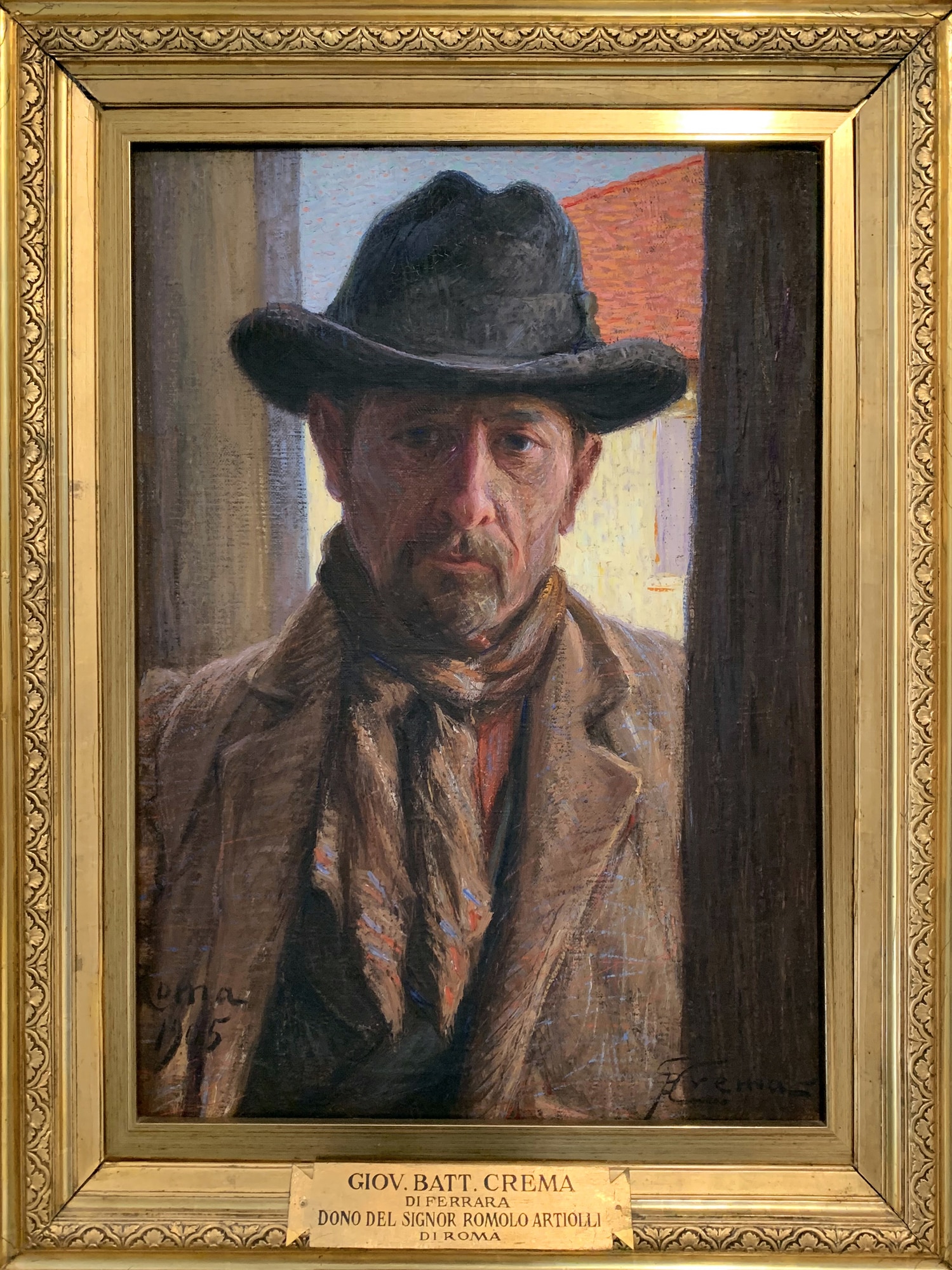
Museo Revoltella, painting by Giovanni Battista Crema Ferrara, 1905.
The Revoltella Museum is not only an exhibition venue, but also a centre for research and art promotion. By collaborating with national and international art and cultural institutions, the museum plays a key role in the dissemination of artistic culture and the promotion of emerging artists.
Visiting the Revoltella Museum will allow you to discover another aspect of Trieste, a city that has always had a deep connection with art and culture. The museum building itself is a work of art, with its elegant architecture and refined interior reflecting the taste and vision of its founder. If you are an art lover or simply want to enrich your trip with a cultural experience, the Revoltella Museum is a stop you cannot miss.
La St Spyridon Orthodox Church in Trieste is a symbol of faith and culture that reflects the city's religious diversity. Built in 1868, the church is a magnificent example of neo-Byzantine architecture. The interior is decorated with beautiful mosaics and golden icons, creating an atmosphere of deep spirituality. Located in the heart of the city, near the Grand Canal, the church is not only a place of prayer, but also a cultural meeting point for the many believers and tourists who visit it every year.
The church is dedicated to St Spyridon, the patron saint of sailors, and serves as a place of worship for the Serbian Orthodox community in Trieste. The façade of the church is imposing, with blue domes shining in the sunlight and architectural details reminiscent of the Byzantine style. Inside, the walls are adorned with golden icons and frescoes telling sacred stories, creating an ambience that invites reflection and contemplation.
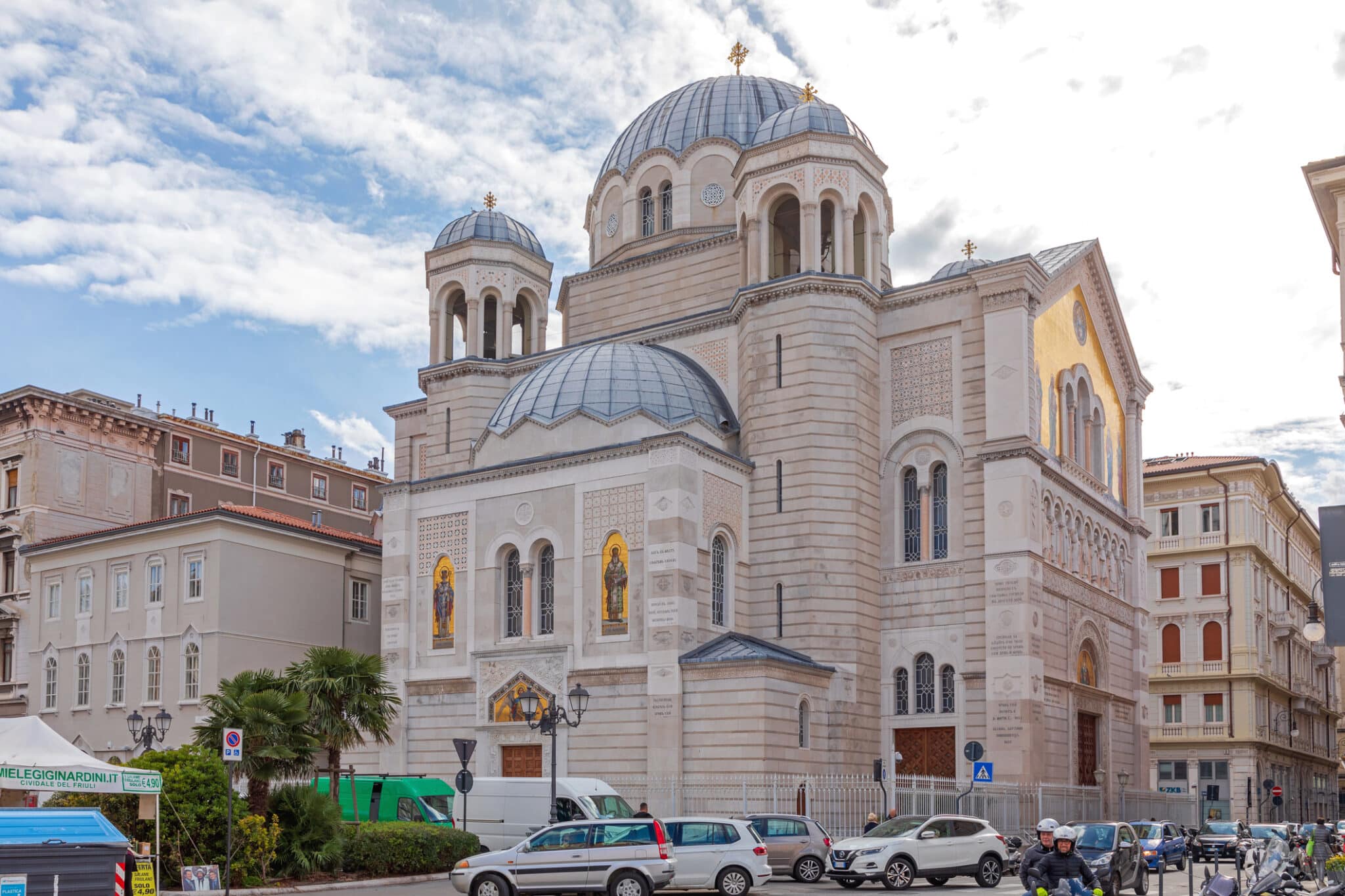
Serbian Orthodox Church Trieste Trieste, Italy
La St Spyridon Orthodox Church is not only a religious building, but also a symbol of the historical and cultural presence of the Serbian Orthodox community in Trieste. Its construction was made possible thanks to contributions from the community and the support of the local authorities, who recognised the importance of maintaining the city's religious and cultural diversity. Today, the church continues to be a vital centre for the community, hosting liturgical celebrations, weddings, baptisms and other religious ceremonies.
The church is also an important tourist attraction, visited by thousands of people every year. Its central location near the Grand Canal makes it easily accessible and an integral part of Trieste's tourist route. Visiting the Orthodox Church of San Spiridione is an experience that allows one to appreciate not only the art and architecture, but also the cultural and spiritual richness of Trieste.
The Barcolana is one of the most famous regattas in the world, held every year in the Gulf of Trieste the second Sunday in October. This event attracts thousands of boats and participants, from professional sailors to enthusiasts. Founded in 1969, the Barcolana has grown exponentially, becoming a symbol of the Trieste maritime culture and a festive occasion for the entire city. The regatta, originally conceived as a local competition, has developed over the years into an event of international significance, attracting participants from all over the world and becoming one of the most crowded and popular sailing events.
During the Barcolana Week, Trieste comes alive with a series of side events including exhibitions, concerts, conferences and activities for all. The streets and piers of the city centre fill with visitors, creating a festive and vibrant atmosphere. Shops, bars and restaurants stay open until late, offering local specialities and live entertainment. The city becomes one big open-air stage where the passion for sailing and the sea is celebrated. Among the most anticipated events are preliminary regattas, acrobatic displays and vintage boat races, which attract the attention of enthusiasts and onlookers alike.

Barcolana
The climax of the event is the regatta itself, which sees thousands of colourful sails whizzing across the gulf in a breathtaking spectacle. The start of the race, with the boats lining up along a starting line of over a kilometre, is one of the most spectacular moments. The entire city comes to a halt to witness this unique event, with the banks and surrounding hills filling with spectators ready to cheer on their favourite crews. The Barcolana is not only a sporting competition, but also a social event that involves the entire city, creating a sense of community and belonging.
The regatta is open to everyone, from the smallest sailboats to luxury yachts, making the event inclusive and accessible to sailors of all levels. This openness contributes to a unique mix of participants, from Olympic champions to amateurs, all united by their passion for sailing. La Barcolana è anche un’occasione per promuovere la sostenibilità e il rispetto per l’ambiente marino. Negli ultimi anni, gli organizzatori hanno introdotto diverse iniziative ecologiche per ridurre l’impatto ambientale della manifestazione, promuovendo pratiche di navigazione sostenibile e sensibilizzando il pubblico sull’importanza della protezione del mare.
Il successo della Barcolana ha portato alla sua crescita continua, con un numero sempre maggiore di imbarcazioni iscritte ogni anno. La manifestazione è diventata una vetrina per Trieste, mettendo in luce non solo la sua tradizione marittima, ma anche la sua bellezza paesaggistica e la sua ricca offerta culturale. Ogni edizione della Barcolana è un’occasione per scoprire nuove storie di mare, fare nuove amicizie e celebrare la passione per la vela in uno dei contesti più suggestivi del Mediterraneo.
The Porto di Trieste è uno dei più importanti e trafficati porti del Mediterraneo, con una storia ricca e affascinante che si estende per oltre tre secoli. Fondato ufficialmente come porto franco nel 1719 dall’Imperatore Carlo VI, il porto ha sempre giocato un ruolo cruciale nel commercio internazionale, specialmente durante l’epoca dell’Austro-Hungarian Empire. Grazie alla sua posizione strategica, Trieste è diventata un punto nodale per i traffici marittimi, collegando l’Europa centrale con il Mediterraneo e oltre.
Durante il XVIII secolo, Trieste divenne un hub commerciale di primaria importanza, grazie alle sue relazioni con il mercato coloniale britannico e alla capacità di penetrare il commercio transatlantico. La città attrasse mercanti da tutto il mondo, inclusi ebrei di Dresda e imprenditori americani, creando un melting pot culturale e commerciale unico. La costruzione del Porto Vecchio tra il 1868 e il 1883, su progetto di Paul Talabot, segnò un significativo ampliamento delle infrastrutture portuali. Questo ampliamento fu favorito dall’apertura del Canale di Suez nel 1869, che aumentò enormemente il traffico marittimo tra l’Europa e l’Oriente.
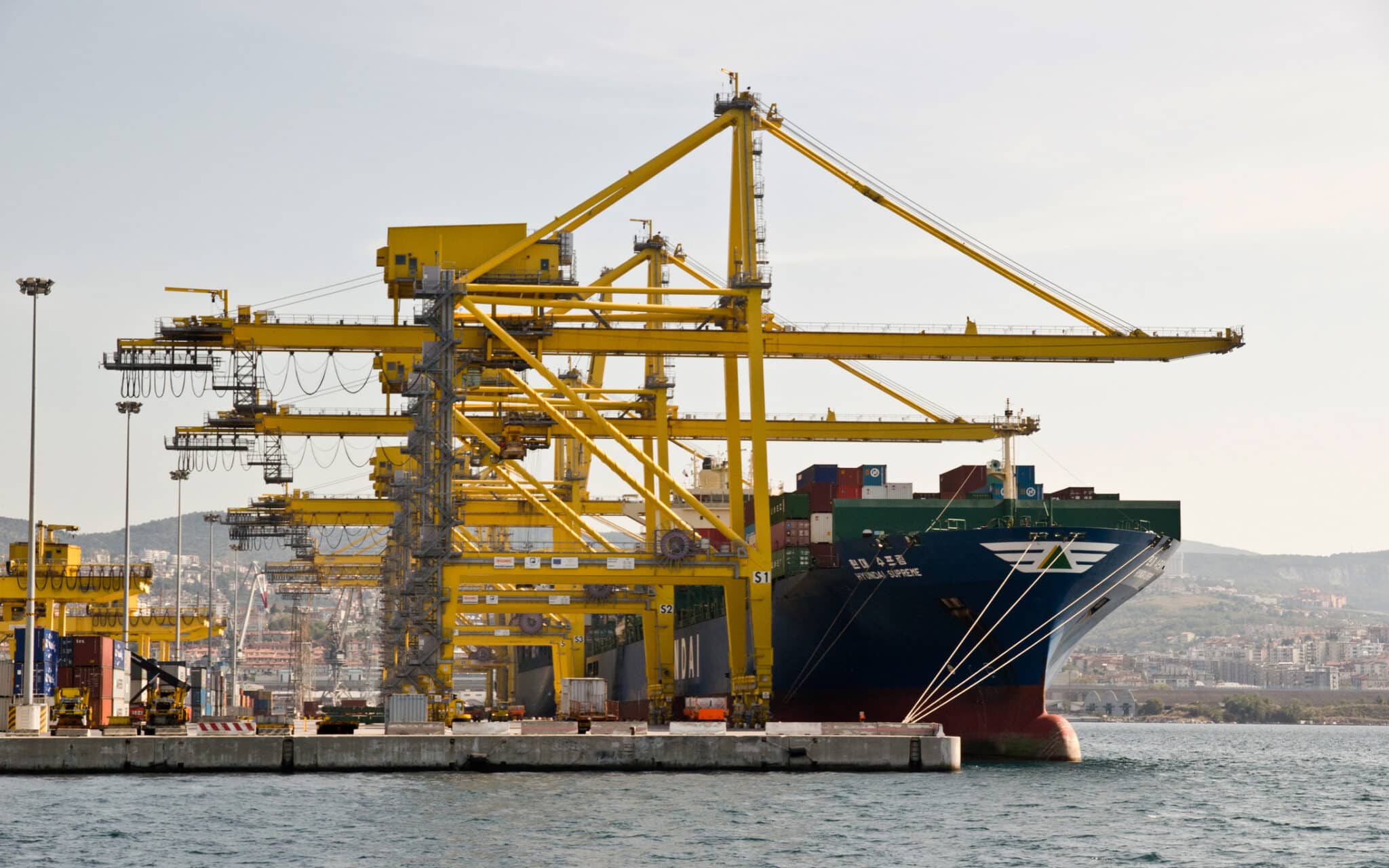
Veduta del porto di Trieste verso il mare con nave per il trasporto di container
Nel XX secolo, il porto di Trieste affrontò numerose sfide, inclusi i danni della World War I e le successive occupazioni. Durante gli anni della guerra, il porto subì danni significativi, ma fu rapidamente ricostruito e modernizzato negli anni ’20 e ’30 con la costruzione del Porto Nuovo. Questo nuovo porto, con le sue strutture moderne, contribuì a mantenere Trieste come uno dei principali snodi commerciali del Mediterraneo. Negli anni successivi, il porto continuò a crescere, diventando un hub cruciale per il traffico di merci e passeggeri.
Oggi, il Porto di Trieste è dotato di infrastrutture all’avanguardia, inclusi terminal per container, infrastrutture ferroviarie e un terminal passeggeri moderno. Il porto è un punto di riferimento per il trasporto intermodale, con collegamenti efficienti che permettono il trasferimento rapido delle merci tra nave, ferrovia e strada. Questo ha reso Trieste un hub logistico di importanza strategica non solo per l’Italia, ma per l’intera Europa. Grazie a continui investimenti e progetti di ampliamento, il porto di Trieste è destinato a mantenere la sua rilevanza e a crescere ulteriormente nel futuro.
We are a young Web Agency with more than 10 years of experience, we love travelling and discovering new places, that is why we write every day on Italia Delight our travel site.

Italia Delight is your definitive guide to Italian restaurants, offering a comprehensive directory and web marketing services to enhance every dining experience. Discover, taste and connect with Italian tradition.
2024 G Tech Group S.R.L.S. - Via di Gagia 22,38086 Giustino (TN) - P.IVA 02743570224
Project in collaboration with Gianluca Gentile e Glocal Consulting
To provide the best experiences, we and our partners use technologies like cookies to store and/or access device information. Consenting to these technologies will allow us and our partners to process personal data such as browsing behavior or unique IDs on this site and show (non-) personalized ads. Not consenting or withdrawing consent, may adversely affect certain features and functions.
Click below to consent to the above or make granular choices. Your choices will be applied to this site only. You can change your settings at any time, including withdrawing your consent, by using the toggles on the Cookie Policy, or by clicking on the manage consent button at the bottom of the screen.